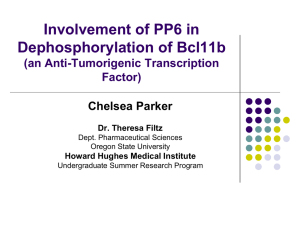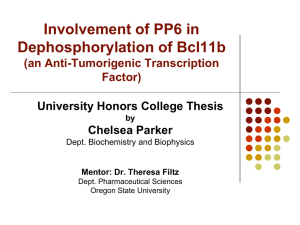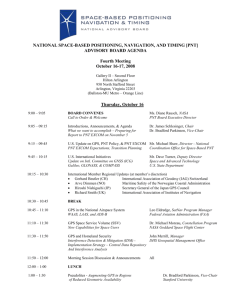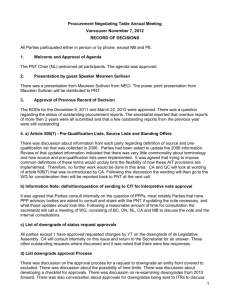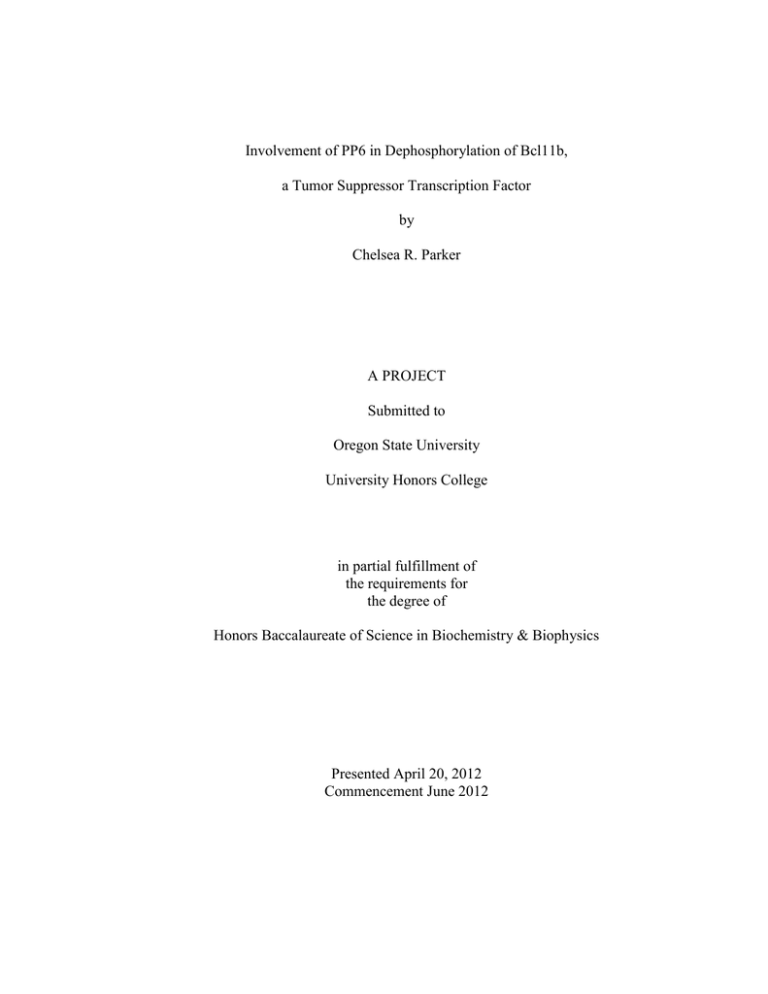
Involvement of PP6 in Dephosphorylation of Bcl11b,
a Tumor Suppressor Transcription Factor
by
Chelsea R. Parker
A PROJECT
Submitted to
Oregon State University
University Honors College
in partial fulfillment of
the requirements for
the degree of
Honors Baccalaureate of Science in Biochemistry & Biophysics
Presented April 20, 2012
Commencement June 2012
AN ABSTRACT OF THE THESIS OF
Chelsea R. Parker for the degree of Honors Baccalaureate of Science in Biochemistry &
Biophysics from Oregon State University presented on blank date. Title: Involvement of
PP6 in Dephosphorylation of Bcl11b, a Tumor Suppressor Transcription Factor.
Abstract Approved: _________________________________________
Theresa M. Filtz
The purpose of this honors thesis research project is to investigate the molecular
causes of childhood and infant T-cell acute lymphoblastic leukemias. T-cells are the work
horses of the immune system, and like any organ, must develop properly to be fully
functional. Improper development of thymocytes into T-cells can lead to development of
T-cell leukemias and lymphomas. Regulation of thymocyte development is coordinated
by transcription factors, of which Bcl11b is essential for proper T-cell development.
Bcl11b is regulated by phosphorylation and dephosphorylation. Previously, a correlation
was found between dephosphorylation of Bcl11b and increased expression of Id2 in
developing T-cells. Regulation of the tumorigenic Id2 gene is crucial for proper T-cell
development. Based on preliminary studies, we hypothesized that PP6 is the phosphatase
responsible for dephosphorylating Bcl11b and altering transcriptional activity of the Id2
gene. DNA constructs for PP6 and Bcl11b proteins were transfected into HEK-293T
cells, and then cells were lysed and assayed for Bcl11b phosphorylation. Our results
indicated that PP6 co-expression increased Bcl11b dephosphorylation in HEK-293T
cells. However, reporter gene assays showed that PP6 co-expression has no effect on
Bcl11b-dependent repression of the Id2 promoter in transfected HEK-293T cells. The
next step is to investigate whether PP6 down-regulation of Bcl11b affects Id2 expression
in native thymocytes.
Key Words: Transcription Factor, Bcl11b, T-ALL, PP6
Correspondence: parkercr.27cp@gmail.com
© Copyright by Chelsea R. Parker
April 20, 2012
All Rights Reserved
Involvement of PP6 in Dephosphorylation of Bcl11b,
a Tumor Suppressor Transcription Factor
by
Chelsea R. Parker
A PROJECT
Submitted to
Oregon State University
University Honors College
in partial fulfillment of
the requirements for
the degree of
Honors Baccalaureate of Science in Biochemistry & Biophysics
Presented April 20, 2012
Commencement June 2012
Honors Baccalaureate of Science in Biochemistry and Biophysics project of Chelsea R.
Parker presented on April 20, 2012.
APPROVED:
Mentor, representing Pharmaceutical Sciences
Committee Member, representing Biochemistry and Biophysics
Committee Member, representing Pharmaceutical Sciences
Department Chair, Pharmaceutical Sciences
Dean, University Honors College
I understand that my project will become part of the permanent collection of Oregon
State University, University Honors College. My signature below authorizes release of
my project to any reader upon request.
Chelsea R. Parker, Author
ACKNOWLEDGEMENTS
I would like to thank the Howard Hughes Medical Institute and the Department of
Pharmaceutical Sciences for funding my wonderful experience in the HHMI summer
research program. I also appreciate the time and mentorship of Dr. Theresa Filtz and Dr.
Kevin Ahern. I would like to thank Dr. Lingjuan Zhang, Xiao Liu, Dr. Walter Vogel and
Dr. Mark Leid for the provision of preliminary data for this project. Special thanks to
Andrew Hau and Dr. Jane Ishmael for the HEK-293T cells, and to Dr. David Brautigan,
who graciously provided me with PP6 constructs and antibodies. Lastly I would like to
recognize Connie Shen, my undergraduate lab partner, for support and assistance.
TABLE OF CONTENTS
Page
THESIS STATEMENT ……………………………………………………………... 1
INTRODUCTION ....................................................................................................... 2
T-ALL ……………………………………………………………………..… 2
T-cell development ………………………………………………………….. 2
Transcription factors ……………………………………………………….... 4
Bcl11b ………………………………………………………………….…… 6
Research goals ………………………………………………………………. 8
MATERIALS AND METHODS ……………………………………………….…. 10
Cell lines ………………………………………………………………..….. 10
Plasmids and transfection ……………………………………………......… 10
Phosphorylation assays and Western blotting ……………………….…….. 10
Reporter gene assays ……………………………………………….……… 11
RESULTS ………………………………………………………………….…….… 13
DISCUSSION ……………………………………………………………………... 18
WORKS CITED ……………………………………………………………..…….. 22
LIST OF FIGURES
Figure
Page
1. The process of thymocyte development …………………………………………… 3
2. PP6 co-expression reduced basal phosphorylation
of Bcl11b but not after PMA stimulation for 4 hours …………………….……......13
3. Dephosphorylation of Bcl11b is observed when co-expressed
with PP6 or H114A, with and without PMA stimulation for 30 min……...………..14
4. CAT Reporter Assay shows PP6 co-expression with
Bcl11b has no effect on Id2 repression………………………………….……….…15
DEDICATION
My UHC Thesis is dedicated to my parents, who taught me to always do my best.
Involvement of PP6 in Dephosphorylation of Bcl11b,
a Tumor Suppressor Transcription Factor
THESIS STATEMENT
The transcription factor Bcl11b is dephosphorylated by PP6 in HEK-293T cells,
ultimately causing de-repression (expression) of the Id2 gene.
2
INTRODUCTION
T-ALL
T-cell Acute Lymphoblastic Leukemia, or T-ALL, is an aggressive hematopoietic
cell cancer. Unfortunately, T-ALL disproportionately affects children, and according to
the American Cancer Society, T-ALL represents 15%-18% of all childhood acute
leukemias (“What Are the Key Statistics for Childhood Leukemia?”). Childhood T-ALL
is associated with a moderate rate of relapse (Hoang and Hoang 2010). The tumor is not
actually a solid mass because the cancer is the result of uncontrolled proliferation of
improperly differentiated thymocytes (T-cell stem cells). T-cells are a crucial component
of the adaptive immune system; T-ALL cancer patients are also immune-compromised
and at risk of developing infections and anemia. Genetic analysis of patients with T-ALL
has yielded many insights as to the mutations and mechanisms involved in disease
progression, but there is still much to learn. Current research on the molecular causes of
T-ALL hopes to shed light on possible treatments to help improve the prognosis for many
young patients.
T-cell development
In a healthy individual, thymocytes are initially formed in the bone marrow as
pluripotent hematopoietic stem cells. Instead of completing their development in the bone
marrow, thymocytes migrate to the thymus and undergo an extensive maturation and
proliferation process. This process requires carefully orchestrated genetic expression
3
changes to form functional T-cells for the immune system. Many more thymocytes are
produced than survive; as the cells develop and commit to the different possible lineages,
they are deleted from the repertoire if they do not function correctly (Murphy 2008).
Figure 1. The process of thymocyte development, as described by E. V. Rothenberg
and modified by M. Leid and T. Filtz (Rothenberg and Taghon 2005).
The surface of differentiating T-cells is embedded with many different receptors
(TCRs) and cell markers (Th1, Th2, CD3, CD8, CD4, etc). CD4 and CD8 TCRs are
multi-subunit proteins comprised of α and β chains. The expression of these surface
proteins changes over time as the cell matures and rearranges its genes to produce TCR
combinations that will be unique to each cell. When cells express neither CD4 nor CD8
T-cell co-receptors, they are said to be at the double-negative or DN stage (there are
4
several subsets of the DN stage) (Figure 1). Thymocytes at this stage have not yet
committed to the T-cell lineage; they may still differentiate to become NK cells or other
myeloid cells (Li, L et al. 2010; Di Santo 2010). Cells that express Kit and CD44 but not
CD25 are called DN1 cells. DN2 cells express CD25, and later, CD44 and Kit expression
is reduced in the DN3 stage. At the DN3 stage, the cell is also expressing a pre-T-cell βreceptor and exhibits full T-lineage-specific gene expression. If the pre-T-cell β-receptor
is properly formed, the cell passes through the commitment checkpoint known as βselection. After β-selection, the cell has committed to the αβ lineage. This particular
assortment of cell surface receptors leads to T-cell proliferation and the expression of
both CD4 and CD8 to form double-positive (DP) cells. This is the start of TCRdependent selection. At this stage, cells test the efficacy of the α-chain TCR, and undergo
positive selection if they are able to recognize self-peptide presented on self-Major
Histocompatibility Complex (MHC) markers. After a cell has been positively selected, it
becomes a single positive (SP) cell - it will only express CD4 or CD8 co-receptors, but
not both. SP cells then migrate through the thymus for additional selection. In this stage,
known as negative selection, T-cells that react too strongly to self peptides are deleted
(Murphy 2008; Rothenberg et al. 2010; Rothenberg and Taghon 2005).
Transcription factors
Cells must use the information encoded in their DNA to make the proteins that are
necessary for cellular function and development. To do this, cells first transcribe their
DNA into messenger RNA (mRNA) using an enzyme called RNA Polymerase, which
5
reads the DNA template and builds an RNA chain complementary to it. The mRNA
molecule contains the genetic information needed to synthesize polypeptide chains from
amino acids. The process of making mRNA is called transcription and the process for
producing polypeptide chains is called translation. Transcription is a highly regulated
process that occurs in the nucleus of eukaryotic cells. Transcription factors, sometimes
called sequence-specific DNA-binding proteins, bind to certain DNA sequences to
regulate gene expression. By binding to promoter or silencer DNA sequences adjacent to
(but sometimes distant from) genes, transcription factors either activate or repress the
recruitment of RNA Polymerase proteins, thus affecting gene transcription (Latchman
2008). Transcription factors can perform these functions alone but most require a
complex of other proteins. There are a variety of transcription factor families which
organize the different proteins into groups based on function and protein structure.
Transcription factor function is often affected and altered by other regulatory proteins,
e.g. kinases and phosphatases, which relay information signals from the cell surface to
the transcription machinery inside the nucleus.
The entire process of thymocyte development requires the combined effort of a
variety of proteins including transcription factors and their regulators to coordinate the
expression of genes necessary for thymocyte maturation (Rothenberg et al. 2010). Some
proteins are crucial for the gene rearrangements that produce the T-cell receptors, and
others regulate or induce cellular changes required for proliferation. Sometimes, the same
transcription factor is activated at more than one point in development, or performs
different functions in different stages. Since the process of thymocyte development is so
6
complicated, it is critical that all of the signaling cascades, transcription factors, and other
cellular machinery function properly.
Bcl11b
T-ALL occurs when there are errors in the thymocyte maturation and proliferation
process; thymocytes reach a certain point in the process and continue to proliferate
without any further maturation or specialization. The body’s circulatory system and
immune system become clogged with useless, non-functioning cells. Although it is
unknown exactly what goes wrong during thymocyte development to cause T-ALL,
researchers have hypothesized that one transcription factor called Bcl11b (also known as
COUP-TF Interacting Protein 2, or CTIP-2) plays a crucial role in the differentiation and
specification process. Previous research has shown that Bcl11b is required for positive
selection and survival of double positive thymocytes (Albu et al. 2007; Wakabayashi et
al. 2003; Kastner et al. 2010; Rothenberg et al. 2010). Bcl11b was originally isolated and
cloned in the laboratory of Dr. Mark Leid at Oregon State University (Avram 2000).
Bcl11b has never been crystallized, but its sequence contains homology to several
domains whose structures are generally known. It is a Krüppel-like zinc finger
transcription factor encoded on human chromosome 14q32.2 with six zinc finger domains
(Satterwhite 2001). Zinc finger proteins contain polypeptide chains that bind four zinc
atoms coordinated by two cysteine and two histidine (C2H2) residues which act as a DNA
binding site (Latchman 2008).
7
In thymocytes, mutation of loss of Bcl11b results in dysregulation (too much or
too little expression) of genes, while overexpression of wildtype Bcl11b can reduce
cellular proliferation (Kastner et al. 2010; Karlsson et al. 2007). Like many transcription
factors, Bcl11b proteins regulate the expression of over 1,000 different genes as
thymocytes develop and are necessary for T-cell lineage commitment, especially in the
DN2 stage of development (Kastner et al. 2010; Wakabayashi et al. 2003). Mutations or
deletions of the Bcl11b gene have been reported in 16% of human T-ALL cases
(Przybylski et al. 2005; De Keersmaecker et al. 2010). Researchers report that, in mouse
models, missense and frameshift mutations of Bcl11b were found in 15% of induced
lymphomas, and all mutations were located in the region coding for the three C-terminus
DNA-binding zinc fingers (Karlsson et al. 2007). In murine models of T-ALL,
thymocytes never develop past the DN2 stage if Bcl11b is knocked out, will not progress
to the DN3 stage, and maintain NK-cell lineage potential (Ikawa et al. 2010; P. Li et al.
2010; Li, L. et al. 2010). Research has also shown that Bcl11b is crucial for positive
selection of DP to SP cells and CD8+ T-cell immune function (Kastner et al. 2010;
Zhang, S. et al. 2010). If Bcl11b is knocked out at the DP stage, positive selection does
not occur. Microarray assays in mice show that Bcl11b is a co-regulator that can act as
both a repressor and activator, depending on the gene and developmental stage (Kastner
et al. 2010). Thus far, research indicates that Bcl11b is always associated with the NuRD
complex, which is comprised of twelve or more polypeptides and is important for
repression across the genome (Topark-Ngarm et al. 2006).
Of the genes that Bcl11b is known to regulate, cKrox and Runx3 are genes that
determine whether a DP cell will become either CD4+ or CD8+ SP cells. CD9, CD160,
8
and integrin are cell surface proteins whose expression is regulated by Bcl11b. When
surface levels of these proteins change it affects which environmental signals are sensed
by the cells. Bcl11b is also a known suppressor of the tumorigenic Id2 gene. Id proteins
play important roles in lymphocyte development and CD8+ T-cell immunity, but
dysregulation can be problematic (Rivera and Murre 2001; Cannarile et al. 2006). Overexpression of Id2 can result in tumor growth and T-cell lymphomas like T-ALL
(Lasorella et al. 2001).
Researchers in Dr. Mark Leid’s lab discovered a correlation between
dephosphorylation of Bcl11b and increased expression of Id2 in thymocytes (developing
T-cells). Data from Dr. Theresa Filtz’s lab in the OSU College of Pharmacy has shown
that in stimulated mouse thymocytes, Bcl11b undergoes several kinetically concerted
changes, first undergoing rapid phosphorylation over a period of 5 min, followed by
dephosphorylation at 30 min, then a slower return to basal phosphorylation levels over 2
hours. Unpublished data from Dr. Filtz’s and Dr. Leid’s labs also indicates that other
post-translational modifications of Bcl11b include sumoylation and ubiquitination
(Zhang, L. et al. 2012). All of these alterations are part of the pathways that regulate
Bcl11b and ensure that its expression and function is properly maintained throughout
thymocyte development. It is important to understand these processes to obtain a better
understanding of the molecular causes of childhood T-ALL and that will hopefully lead
to the development of better treatments against the disease.
Research goals
9
One of the primary goals of this project was to identify the phosphatase involved
in the dephosphorylation of Bcl11b. Based on studies of proteins that interact with
Bcl11b, we hypothesized that PP6 is the phosphatase responsible for dephosphorylating
Bcl11b upon stimulation of thymocytes. A secondary component of the project was to
investigate the role that dephosphorylation of Bcl11b plays in the regulation of
transcription of the Id2 gene promoter in a Bcl11b over-expression system (Human
Embryonic Kidney cells (HEK-293T)). Identification of the phosphatase that affects
Bcl11b is important because it may be possible to target that molecule for treatment of
these aggressive childhood cancers and other diseases in humans.
10
MATERIALS AND METHODS
Cell lines
HEK-293T cells (1x106 cells/plate) were grown in DMEM media supplemented
with 10% FBS, 100 U/ml penicillin and 100 μg/ml streptomycin from Mediatech. Cells
were grown at 37°C with 5% CO2 humidity in 10 cm tissue culture plates. Cells were
rinsed with 1x Trypsin EDTA (0.23% Trypsin, 2.21mM EDTA in HBSS) from
Mediatech for passage.
Plasmids and transfection
Id2 reporter gene constructs, β-galactosidase, and Bcl11b “F-CTIP-2 Mt20”
cDNA-containing mammalian expression plasmids purified by CsCl2 were kindly
provided by Lingjuan Zhang and Dr. Mark Leid. Wild-type PP6 and H114A (mutant
PP6) mammalian expression plasmids were kindly provided by Dr. David Brautigan of
the University of Virginia. To control for transfection efficiency, control samples
received pcDNA3 mammalian expression vector without inserts. HEK-293T cells were
transfected using the Calcium-Phosphate method (Five Photon Biochemicals protocol)
with 5 μg of DNA or less per 10 cm plate and allowed to incubate 48 hours before
treatments.
Phosphorylation assays and Western blotting
11
Cells were treated with 1 μM PMA (Sigma-Aldrich) and 500 nM A23187 (EMD
Biosciences) in 100% DMSO vehicle at 48 hours post transfection to stimulate
phosphorylation. For time-course experiments, cells were incubated with PMA-A23187
treatment for 4 hours, 1 hour, 30 min, 5 min, and 0 min before harvesting. Invitrogen
NUPAGE BisTris 4-12% gradient gels were used for Western blots. Anti-CTIP2
polyclonal antibodies were obtained from Abcam. The anti-phospho-Thr antibodies were
purchased from Cell Signaling and anti-PP6 antibodies were a generous gift from Dr.
David Brautigan. Blots were developed with standard ECL reagents.
Reporter gene assays
HEK-293T cells were transfected with Id2-reporter, β-galactosidase, Bcl11b, and
PP6 constructs. To create the Id2 reporter construct, a -2.9 to +0.152 kb fragment from
the mouse Id2 locus was subcloned into the pCR2.1 vector in front of the
chloramphenicol acetyl transferase gene as described by Lingjuan Zhang (Zhang, L. et al.
2012).
The β-galactosidase expression vector (pCMV-Sport-βGal, Life Technologies)
was co-transfected as an internal control for normalization of transfection efficiency and
protein expression. β-galactosidase activity was measured by addition of 0-nitrophyenylβ-D-galactopyranoside, and reactions proceeded at 30°C until a visible color change was
evident (~20 min). The colorimetric A240 absorption of each sample was then measured.
Protein assays were conducted on lysates as described elsewhere (Dowell et al.).
12
Cells were harvested 48 hours post transfection and lysed by repeated freezing
and thawing cycles. Cellular debris was removed by centrifugation, at which point the
lysate was incubated with [14C] chloramphenicol and acetyl-coenzyme A. Relative
chloramphenicol acetyl transferase activity was determined by monitoring the acetylation
of chloramphenicol by autoradiography following thin-layer chromatography (TLC). The
percent conversion of non-acetylated to acetylated products was measured by excising
the radioactive spots corresponding to substrate and product from the TLC plate and
quantifying β-emission in a scintillation counter (Carey, Peterson, and Smale).
13
RESULTS
Figure 2. PP6 co-expression reduced basal phosphorylation of Bcl11b but not after
PMA stimulation for 4 hours. HEK-293T cells were transfected with plasmids
containing Bcl11b (all lanes) or PP6 (lanes 2, 4, 6, and 8) as described. 48 hours posttransfection, cells were treated with PMA (1.0 μM) or DMSO as indicated above blots.
Samples were harvested after 4 hours and immunoprecipitated with anti-Bcl11b
antibodies prior to separation by SDS-PAGE and immunoblotting with antibodies
indicated at left. Shown are immunoblots of the 100-150kDa bands for blots with antiBcl11b and anti-pThr antibodies, and the 35-55kDa bands for anti-PP6. This experiment
was repeated at least twice.
The results in Figure 2 are representative of the outcome of several repeated
experiments designed to test the ability of PP6 to dephosphorylate Bcl11b with and
without PMA stimulation. 48 hours after transfection with plasmids containing PP6 and
Bcl11b, cells received treatment with PMA as indicated in Figure 2. After 4 hours of
PMA exposure, the cells were lysed and immunoprecipitated with Bcl11b antibodies to
detect phosphorylation by Western blot with anti-phosphothreonine antibodies. The
immunoblots show that Bcl11b was expressed in every lane as expected, and PP6 was
expressed in samples that were transfected with PP6. In groups that were transfected with
PP6 and not stimulated with PMA (Figure 2 Lanes 6 and 8), it appears that PP6 was able
14
to decrease basal levels of Bcl11b phosphorylation. However, samples that were
transfected with PP6 and stimulated for 4 hours with PMA (Figure 2 Lanes 2 and 4)
showed high levels of phosphorylation, suggesting that PP6 could not overcome the
phosphorylating effects of PMA at the 4 hour time point.
We repeated the experiment described by Figure 2, but limited PMA treatment to
30 min. The results are shown in lanes 1-4 of Figure 3. When PMA stimulation is limited
to 30 min, PP6 reduced basal phosphorylation and blocks PMA-stimulated
phosphorylation of Bcl11b.
Figure 3. Dephosphorylation of Bcl11b is observed when co-expressed with PP6 or
H114A, with and without PMA stimulation for 30 min. HEK-293 cells were
transfected with plasmids containing Bcl11b (all lanes), PP6 (as indicated above blots), or
H114A (as indicated above blots). Cells were treated with PMA or DMSO as indicated
for 30 min at 48 hours post-transfection.
Samples were harvested and
immunoprecipitated with anti-Bcl11b antibodies prior to separation by SDS-PAGE and
immunoblotting with antibodies against Bcl11b, pThr, or PP6. Shown are immunoblots
of the 100-150kDa bands for blots with anti-Bcl11b and anti-pThr antibodies, and the 3555kDa bands for anti-PP6/H114A. This experiment was repeated at least twice.
15
To further test the hypothesis that the Bcl11b transcription factor is
dephosphorylated by PP6, HEK-293T cells were transfected by the calcium phosphate
method with plasmids containing cDNAs for Bcl11b, PP6, and some received the mutant
PP6 construct H114A. H114A is a point mutant which lacks phosphatase catalytic
activity. The vector pcDNA3 was used to control for the amount of DNA each plate of
cells received. After the HEK-293T cells had been allowed sufficient time to express the
new genes (48 hours), some were stimulated with PMA to initiate Bcl11b
phosphorylation. If our hypothesis was correct, we should have seen less Bcl11b
phosphorylation in samples where PP6 was present. However, the results depicted in
Figure 3 display a confounding effect of PP6 over-expression in our assays. When either
PP6 or its catalytically inactive mutant H114A were greatly overexpressed in HEK-293T
cells along with other DNA constructs, lower levels of expression of Bcl11b were
observed (Figure 3 Lanes 3-6).
16
Figure 4. CAT Reporter Assay shows PP6 co-expression with Bcl11b has no
effect on Id2 repression. A) HEK-293 cells were transfected with plasmids containing
an Id2 promoter-CAT reporter gene construct (all lanes), Beta-galactosidase (all lanes),
Bcl11b (lanes 3, 4, 7, and 8), or PP6 (lanes 5, 6, 7, and 8) as indicated. Beta-gal
quantification was used to normalize DNA expression across all samples (not shown).
Radioactive C14 was used to tag the CAT substrate to quantitate regulation of the Id2
promoter by Bcl11b in the transfected cells in the absence and presence of PP6. B) Basal
levels of Id2 promoter-CAT reporter expression without co-expression of Bcl11b is
shown in the first column. Expression levels decrease by approximately 32% when coexpressed with Bcl11b, as shown in the second column. When co-expressed with PP6,
the Id2 promoter-CAT reporter construct shows no repression. Id2 promoter-CAT
reporter expression levels decrease by approximately 37% when co-expressed with
Bcl11b and PP6. C) Western blots were conducted on samples shown in Figure 4A
corresponding to sample 4 (Lane1 and sample 8 (Lane 2) following immunoprecipitation
of Blx11b (method as described in Figure 2). Shown are immunoblots of the 100-150
kDA bands for blots anti-pThr antibodies detected by near-IR fluorescent secondary
antibodies and quantitated using a Licor Odyssey near-IR scanner. Phosphorylation of
Bcl11b was reduced by approximately 50% in the presence of co-transfected PP6.
Our second hypothesis was that co-expression of PP6 and Bcl11b results in derepression (increased expression) of the reporter gene controlled by the Id2 promoter.
After discussing the overexpression issues mentioned earlier with members of
collaborating labs, the transfection concentration of PP6 constructs was halved. Since
PP6 reduced basal phosphorylation of Bcl11b in HEK-293T cells, stimulation by PMA
was eliminated for the secondary hypothesis experiments. HEK-293T cells were again
transfected via the calcium-phosphate method, this time with plasmids containing cDNAs
17
for PP6, Bcl11b, Beta-galactosidase, and an Id2 promoter-CAT reporter construct. CAT
assays were used to quantitate regulation of the Id2 promoter by Bcl11b in the transfected
cells in the absence and presence of PP6. The Beta-galactosidase was used to normalize
for DNA expression among samples. The results of the CAT assay demonstrate no
significant difference between Id2 repression by Bcl11b in the absence or presence of
PP6 (Figure 4A and Figure 4B).
18
DISCUSSION
Thymocytes are very difficult to culture and notoriously hard to transfect. HEK293T cells were chosen as a model cell line because they have very low endogenous
levels of PP6. Researchers in collaborating laboratories have also found that Bcl11b is
easily phosphorylated when expressed in these cells. Initially, experimental results with
co-transfection of Bcl11b and PP6 in HEK-293T cells were promising (Figure 2). PP6 is
capable of dephosphorylating Bcl11b in HEK-293T cells in the absence of PMA
stimulation (decreasing basal phosphorylation). The basal levels of phosphorylation of
Bcl11b are quite high in HEK-293T cells. In some experiments, the basal
phosphorylation level was so high that PMA treatment was not very effective at further
increasing Bcl11b phosphorylation. Variable phosphorylation was an issue in obtaining
consistent data over several experiments.
Figure 2 further shows no decrease in phosphorylation for samples treated with
PMA for 4 hours that also express PP6. It appears that PP6 cannot overcome the 4 hour
stimulation with PMA to dephosphorylate Bcl11b. Thus, PP6 may be part of the
regulatory mechanism controlling basal levels of Bcl11b phosphorylation, but may be
inhibited by extended treatment with PMA.
We hypothesized that stimulation of phosphorylation would recreate the
phosphorylation and dephosphorylation cycle of Bcl11b noted in previous experiments
with thymocytes. To test this, we completed several time course experiments with PMA
treatment of varying times (4 hours, 1 hour, 30 min, 5 min, and 0 min) to determine the
treatment dependent kinetic pattern of changes in phosphorylation levels of Bcl11b in the
19
absence of PP6 in HEK-293T cells (results not shown). We compared the
phosphorylation kinetic pattern of Bcl11b in HEK-293T cells with the pattern seen in
thymocytes. The time course experiments indicated that phosphorylation in the model
cell line follows a somewhat similar cycle to that seen in thymocytes with a slight delay.
The highest levels of phosphorylation of Bcl11b occurred at 30 min of PMA treatment
rather than 5 min as in thymocytes. Unfortunately we had some reproducibility issues in
these experiments with varying levels of phosphorylation in samples that received no
PMA treatment. Much of this was due to varying levels of basal phosphorylation.
Based on evidence of elevated Bcl11b phosphorylation after 30 min of PMA
incubation, we decided to use this treatment time for further experiments to discern the
effect of PP6 on Bcl11b phosphorylation levels. As shown in Figure 3, PP6’s ability to
dephosphorylate Bcl11b when PMA stimulation is limited to 30 min is quite evident
(Figure 3 Lane 4); basal levels of Bcl11b phosphorylation were also eliminated by PP6
co-expression in this experiment.
To investigate the specificity of PP6’s effect on Bcl11b phosphorylation levels,
we used H114A as a negative control for PP6. H114A was designed to be a catalytically
inactive mutant of PP6 phosphatase. However, in our hands, H114A was a poor negative
control for PP6 seeing as Bcl11b was dephosphorylated in Figure 3 Lane 6, a sample
which expressed H114A (without PMA treatment). The ability of a catalytically inactive
mutant to reduce Bcl11b phosphorylation was unexpected and requires alternative
hypotheses to explain the action of PP6 co-expression in reducing Bcl11b
phosphorylation levels in HEK-293T cells. Perhaps PP6 stimulates dephosphorylation of
Bcl11b by recruiting other phosphatases into a complex. In this scenario, it is possible
20
that PP6 and H114A are nucleating factors for Bcl11b dephosphorylation by multiple
phosphatases. Another unexpected problem arose in the experiments with PP6 and
H114A co-transfection with Bcl11b. Co-transfection of moderately high levels of PP6 or
H114A with Bcl11b drastically reduces the expression of Bcl11b. Low levels of Bcl11b
may explain why phosphorylation is not evident in lanes containing the negative control
H114A. This co-expression problem of reduced Bcl11b levels in the presence of PP6 or
H114A turned out to be an on-going issue.
We used Id2-CAT reporter assays to investigate the effect of Bcl11b
dephosphorylation on Id2 gene induction or repression. The Id2-CAT reporter assays
were also affected by Bcl11b-independent actions of PP6 to reduce overall expression of
transfected genes in HEK-293T cells (Figure 3). Results from the Id2-CAT reporter gene
assays were inconsistent throughout the project, most likely because of this effect of PP6.
For the experiment portrayed in Figure 4, we used half of the amount of PP6 plasmid for
transfection in an attempt to avoid confounding problems with suppression of protein
expression. In this experiment, PP6 co-expression had less effect on Bcl11b expression
levels and no effect on the transcriptional regulatory activity of Bcl11b towards the Id2
gene promoter. Even so, Bcl11b levels were reduced in the PP6-cotransfected samples,
confounding our results.
The unanticipated effects of PP6 on Bcl11b expression in transfected HEK-293T
have probably doomed this approach to studying the effects of Bcl11b dephosphorylation
on Id2 gene regulation. In the future, Dr. Filtz will continue to pursue other avenues to
study the importance of PP6 in regulation of Bcl11b, potentially by using Bcl11b
phosphosite mutants and PP6 knockdown experiments.
21
Further, Dr. Filtz and Dr. Leid have some new data suggesting that Bcl11b is not
simply regulated by phosphorylation and dephosphorylation cycles. In thymocytes, recent
unpublished data show that Bcl11b is regulated by MAPK-mediated phosphorylation
followed by sumoylation and ubiquitination (Zhang, L. et al. 2012). Sumoylation of
Bcl11b is only minimal in HEK-293T cells, and it may be that Bcl11b must have
sumoylation concurrent with dephosphorylation to increase de-repression of the Id2 gene.
Eventually, findings from this research could be used to develop small molecules to
target against phosphatases and interfere with Bcl11b’s activity in T-cells, perhaps
changing its function in disease.
22
WORKS CITED
Albu, D. I. et al. “BCL11B Is Required for Positive Selection and Survival of Doublepositive Thymocytes.” Journal of Experimental Medicine 204.12 (2007): 3003–
3015.
Avram, D. “Isolation of a Novel Family of C2H2 Zinc Finger Proteins Implicated in
Transcriptional Repression Mediated by Chicken Ovalbumin Upstream Promoter
Transcription Factor (COUP-TF) Orphan Nuclear Receptors.” Journal of
Biological Chemistry 275.14 (2000): 10315–10322.
Cannarile, Michael A et al. “Transcriptional Regulator Id2 Mediates CD8 T Cell
Immunity.” Nature Immunology 7.12 (2006): 1317–1325.
Carey, Michael, Craig L Peterson, and Stephen T Smale. Transcriptional Regulation in
Eukaryotes : Concepts, Strategies, and Techniques. Cold Spring Harbor, N.Y.:
Cold Spring Harbor Laboratory Press, 2009.
Dowell, P. “P300 Functions as a Coactivator for the Peroxisome Proliferator-activated
Receptor Alpha.” Journal of Biological Chemistry 272.52 (1997): 33435–33443.
Hoang, Trang, and Thu Hoang. “The T-ALL Paradox in Cancer.” Nature Medicine
16.Number 11 (2010): 1185–1186.
Ikawa, T. et al. “An Essential Developmental Checkpoint for Production of the T Cell
Lineage.” Science 329.5987 (2010): 93–96.
Karlsson, Anneli et al. “Bcl11b Mutations Identified in Murine Lymphomas Increase the
Proliferation Rate of Hematopoietic Progenitor Cells.” BMC Cancer 7.1 (2007):
195.
Kastner, Philippe et al. “Bcl11b Represses a Mature T-cell Gene Expression Program in
Immature CD4+CD8+ Thymocytes.” European Journal of Immunology 40.8
(2010): 2143–2154.
De Keersmaecker, Kim et al. “The TLX1 Oncogene Drives Aneuploidy in T Cell
Transformation.” Nature Medicine 16.11 (2010): 1321–1327.
23
Lasorella, A, T Uo, and A Iavarone. “Id Proteins at the Cross-road of Development and
Cancer.” Oncogene 20.58 (2001): 8326–8333.
Latchman, David S. Eukaryotic Transcription Factors. Amsterdam; Boston:
Elsevier/Academic Press, 2008.
Li, L., M. Leid, and E. V. Rothenberg. “An Early T Cell Lineage Commitment
Checkpoint Dependent on the Transcription Factor Bcl11b.” Science 329.5987
(2010): 89–93.
Li, P. et al. “Reprogramming of T Cells to Natural Killer-Like Cells Upon Bcl11b
Deletion.” Science 329.5987 (2010): 85–89.
Murphy, Kenneth, Paul Travers, and Mark Walport. Janeway’s Immunobiology. 7th ed.
New York and London: Garland Science, Taylor & Francis Group, LLC, 2008.
Przybylski, G K et al. “Disruption of the BCL11B Gene Through Inv(14)(q11.2q32.31)
Results in the Expression of BCL11B-TRDC Fusion Transcripts and Is
Associated with the Absence of Wild-type BCL11B Transcripts in T-ALL.”
Leukemia 19.2 (2005): 201–208.
Rivera, R, and C Murre. “The Regulation and Function of the Id Proteins in Lymphocyte
Development.” Oncogene 20.58 (2001): 8308–8316.
Rothenberg, Ellen V., and Tom Taghon. “Molecular Genetics of T Cell Development.”
Annual Review of Immunology 23.1 (2005): 601–649.
Rothenberg, Ellen V., Jingli Zhang, and Long Li. “Multilayered Specification of the Tcell Lineage Fate.” Immunological Reviews 238.1 (2010): 150–168.
Di Santo, J. P. “A Guardian of T Cell Fate.” Science 329.5987 (2010): 44–45.
Satterwhite, E. “The BCL11 Gene Family: Involvement of BCL11A in Lymphoid
Malignancies.” Blood 98.12 (2001): 3413–3420.
24
Topark-Ngarm, A. et al. “CTIP2 Associates with the NuRD Complex on the Promoter of
p57KIP2, a Newly Identified CTIP2 Target Gene.” Journal of Biological
Chemistry 281.43 (2006): 32272–32283.
Wakabayashi, Yuichi et al. “Bcl11b Is Required for Differentiation and Survival of Αβ T
Lymphocytes.” Nature Immunology 4.6 (2003): 533–539.
“What Are the Key Statistics for Childhood Leukemia?” Web. 24 Jan. 2012.
Zhang, Ling-juan, Walter K. Vogel, et al. “Coordinate Regulation of Bcl11b Activity in
Thymocytes by the MAPK Pathways and Protein Sumoylation.” Manuscript in
Submission (2012).
Zhang, S., M. Rozell, et al. “Antigen-specific Clonal Expansion and Cytolytic Effector
Function of CD8+ T Lymphocytes Depend on the Transcription Factor Bcl11b.”
Journal of Experimental Medicine 207.8 (2010): 1687–1699.
25
26

